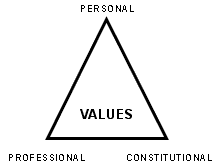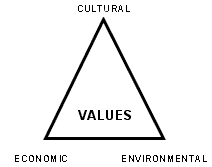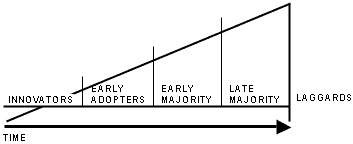October 2004 // Volume 42 // Number 5 // Feature Articles // 5FEA1
Intelligent Consumption: Addressing Consumer Responsibilities for Natural Resources--and Beyond
Abstract
As population, economic, and consumption pressures on natural resources
increase, educating consumers about their responsibilities becomes a
new and necessary expansion of Extension programming. Intelligent consumption
education must incorporate ethics-based methods to be successful. Since
1998, the Sustainable Living Project at OSU has been offering intelligent
consumption programming to typical American adults and older youth. By
taking a thoughtful approach to understanding cultural, economic, and
environmental ethics, considering the barriers to living sustainably,
examining national trends, and determining personal priorities, participants
create an ethical foundation for intelligent consumption decision-making.
Overview
"The American public for many years has been abusing the wasteful lumberman. A public which lives in wooden houses should be careful about throwing stones at lumbermen, even wasteful ones, until it has learned how its own arbitrary demands help cause the waste which it de cries... The long and the short of the matter is that forest conservation depends in part on intelligent consumption, as well as intelligent production of lumber."
~ Aldo Leopold, 1928, "The Home Builder Conserves" (Flader & Caldecott, 1991)
Aldo Leopold was right. At Oregon State University and other land-grant institutions, we focus our educational efforts on teaching students to professionally manage natural resources. However, as population, economic, and consumption pressures increase, addressing the responsibilities of the consumers of natural resources becomes a viable educational tool.
Since 1998, the Sustainable Living Project at OSU has been offering intelligent consumption programming to adults and older youth to create an ethical foundation supporting sustainable management of natural resources. Intelligent consumption is about managing ourselves. It acknowledges the role ethics plays in decision-making. Taking a thoughtful approach to understanding cultural, economic, and environmental values; considering the barriers to living sustainably; examining national trends; and determining personal priorities are all necessary elements in educating the public about their consumer choices.
In this article, I:
-
Use forest resources data as an example of natural resource pressures and forestry's response to them;
-
Propose that educating consumers about their responsibilities is a new and necessary component of our educational efforts in natural resources;
-
Suggest that intelligent consumption is a viable education topic for all Extension professionals, not just those in natural resources;
-
Explain why incorporating ethics-based education into intelligent consumption programming is critical;
-
Describe The Sustainable Living Project, which helps students determine their own economic, cultural, and environmental values and beliefs; and
-
Explain why the time is right for Extension to incorporate such programming.
Pressures
In May 2001, the Wisconsin Academy of Sciences, Arts and Letters and the USDA Forest Service, Forest Products Laboratory released the Report of the Intelligent Consumption Project (Strigel & Meine, 2001). The report identified three massive pressures squeezing global forest resources: population, economic growth, and consumption.
First, world population is currently at 6 billion and is projected to rise to 11 billion within 100 years. If projected increases in human population hold true, by the end of this century, the area of forest per capita in the world will drop from the currently inadequate 1.5 acres to between 0.7 and 0.8 acres (Strigel & Meine, 2001). In the United States, it will be more than halved, from 2.7 acres to about 1.3 acres (Strigel & Meine, 2001).
Second, the World Bank predicts that economic growth in the next 10 years could approach 5% annually in developing countries and 2.8% in industrial countries. The combination of population growth and economic growth will create a worldwide demand for new housing units. Over the next 50 years, that demand is likely to exceed one billion (Strigel & Meine, 2001).
The third pressure on forest resources is consumption, with the United States consuming a disproportionate share. U.S. citizens use twice the average for other developed countries and roughly three times that of the world as a whole (Strigel & Meine, 2001). U.S. consumption is higher than that of any other nation on Earth (Strigel & Meine, 2001), leading two researchers to state, "It would require 4 of our Earths for everybody on the planet to live the lifestyle of North Americans" (quoted in Ryan & Durning, 1997).
These pressures are not unique to forestry. Similar pressures affect all Extension program areas. And our responses and solutions are also similar.
Solutions
Forestry's traditional--and crucial--response to the population, economic, and consumption pressures has been to become more efficient. Our educational programs focus on improving silviculture, harvest, utilization, production, management, and delivery methods. But what about the consumers of forest resources? Don't they have responsibilities too? What kind of educational programming can help them make more informed consumer decisions?
Two caveats. First, one could assume that to ease pressures on forest resources, one should encourage people to reduce consumption of wood products. This assumption is misleading. The Report of the Intelligent Consumption Project strongly cautions, "Contrary to expectations, the result could be highly adverse to the environment in the U.S. and globally. Reduction of wood consumption, without accompanying success in reducing consumption in general, would likely lead to a number of undesirable consequences..." (Strigel & Meine, 2001).
The report cites four negative outcomes:
-
Substitute materials can be less environmentally benign;
-
There would be a resultant increase in metallic and non-metallic mineral extraction globally - with associated social and environmental impacts;
-
Energy usage would increase significantly, including use of fossil fuels to transport materials; and
-
There would be a considerable increase in U.S. net imports, thereby transferring environmental impacts to other countries.
The second caveat is: to make intelligent consumer decisions, consumers must be cognizant of "the right thing to do," a highly individualistic determination generally arrived at after much thought. In Lawrence Kohlberg's body of work on stages of moral development, intelligent consumption decisions match Stage 6, the highest level: "Follow individual conscience and universal principles even if risk is involved" (Kohlberg, 1984).
Ethics-Based Education
Ethics-based education is all about managing ourselves. It creates a philosophical foundation to support decision-making on all levels. It acknowledges that personal values, ethics, and beliefs powerfully influence decisions and actions. (The take-home message for natural resource managers is "To understand environmental facts you have to understand your own values and the values of others" [Smith & Gilden, 2000]).
Self-aware people consciously align--and articulate--personal, professional, and constitutional values (Figure 1.) These values are intertwined, underpinning everything an individual does. They tell the world who she or he is and how she or he goes about his or her business (Simon-Brown, 1999).
Figure 1.
Personal, Professional, and Constitutional Values Triangle

An ethics-based curriculum helps students determine personal values, ethics and facts. These are defined by Smith and Gilden (2000) as follows.
-
Values: What people think is right and wrong, good and bad, desirable and undesirable. They are the lens through which reality is perceived.
-
Ethics: A specific combination of values, creating a body of moral principles.
-
Facts: Truths which are verifiable and socially agreed upon. Facts can change, based on new knowledge. In the 11th century, the earth was flat, a verifiable and socially agreed upon fact.
An example of an Extension program that evolved into an ethics-based education program is the Sustainable Living Project at OSU.
The Sustainable Living Project at OSU
False Start: Focus on Information Transfer
In 1998, the Sustainable Living Project quietly began at Oregon State University. The project's mission, to reduce environmental degradation and improve quality of life in the Pacific Northwest by fostering new consumption patterns and promoting sustainable lifestyles, targeted mainstream adults and older youth. The project defines sustainable living as "A life that is deeply satisfying, fulfilling and appealing, and at the same time, environmentally responsible" (Simon-Brown, 1998).
Original efforts focused on a "one-stop shopping" approach. I provided research-based information on a variety of traditional Extension topics, such as energy conservation and usage, financial management, consumer products, healthy foods, and gardening. It didn't work. Traditional Extension audiences considered the service to be redundant; new audiences didn't engage. The decision point came when a mall shopper stopped at my booth during a Home Show. "Why should I care about this stuff? What's in it for me?" Clearly, I was offering answers to questions that my audience hadn't yet asked themselves.
At about the same time, I read Yearning for Balance: Views of Americans on Consumption, Materialism, and the Environment (The Harwood Group for Merck Family Fund 1995). The report enumerates four key findings:
-
Americans believe our priorities are out of whack.
-
Americans are alarmed about the future.
-
Americans are ambivalent about what to do.
-
Americans see the environment as connected to these concerns--in general terms.
These non-scientific-sounding findings reflect a society at odds with its values. To move Americans from ambivalence to action, the Sustainable Living Project needed to help people think through their personal values and beliefs.
New Focus: Identify Individual Values and Beliefs
Our approach to the project mission changed to: help mainstream adults and older youth make informed consumer decisions by thoughtfully and consciously examining the cultural, economic and environmental aspects of our American lifestyle. In short, participants identify their own Sustainability Triangle of Values.
Figure 2.
Sustainability Triangle of Values

Now, the Sustainable Living workshops:
-
Create a safe intellectual environment for thoughtful dialogue about quality of life issues. This is the foremost requirement.
-
Focus on exploring individual values and beliefs in order to make more-informed decisions.
-
Address the major barriers to achieving quality of life in the United States: time crunch, natural/spiritual disconnect, and consumption/materialism.
-
Act as conduits to other programs, such as Earth Ministry in churches, voluntary simplicity classes and simplicity circles for individuals, and EcoTeams for neighborhood groups.
-
Provide access to research-based information on a variety of traditional Extension topics, such as energy usage, financial management, consumer products, healthy foods, and gardening.
Neutrality is the most essential quality for the instructor to exhibit Πand its importance can't be overstated. Each participant arrives with a lifetime of values and beliefs. It is not the instructor's role to change them or to advocate certain philosophies. It is up to the participants to discover what they believe to be their most important cultural, economic and environmental values. The instructor facilitates that process by using time-honored Extension techniques: asking questions, role-playing, large and small group conversations, readings, and individual journaling.
Since refocusing the project in 1999, more than 5,000 people have participated in workshops and presentations, and over 150,000 people have browsed the Web site <http://www.cof.orst.edu/cof/extended/sustain/>. An overdue formal evaluation and assessment of the project is scheduled for this year.
In 2002, I informally called 25 participants from the 2000 and 2001 workshops to ask 1) if their Sustainability Triangle was displayed and 2) if they used the Sustainability Triangle in decision-making. Twenty-three (92%) said that their Sustainability Triangle was prominently displayed (usually on the refrigerator) and that they consulted it often. Twenty-one (84%) said they had used it in making major family decisions (buying or selling a vehicle or house.) Several ex-participants volunteered that, as a result of the workshops, their families had reduced energy consumption, changed eating and spending habits, and reduced the number of arguments with their teenagers!
Why the Time Is Right: Implications for Extension
Global, national, and regional trends underscore the timeliness of such an ethics-based education effort. According to the World Future Society (Outlook 99, 1998), the following trends affect sustainability of natural resources.
-
The likelihood of an energy-related economic/environmental crisis is increasing. The Middle East conflicts and the recent crash of the Asian economy are two examples. A gasoline crisis is predicted.
-
Sustainability is becoming a central concept in environmental management, ecology, business, and industry.
-
People are increasingly aware of the linkages between personal behavior and environmental health, and industrial behavior and global health.
America is in the midst of a meta-transition. Time and quality of life are becoming relatively more important than money. Sixty-six percent of Americans say they want more balance in their lives. Sixty percent want to simplify their lives (Schor, 1998). The voluntary simplicity movement, which approximately 35 to 40 million Americans espouse, is moving from the early adopter phase to the early majority phase.
Figure 3.
Meta-Transitional Categories

(One sure proof that the concept has become mainstream is the proliferation of commercials by car, banking, and soft drink companies exhorting consumers to simplify their lives--by buying their products.)
Intelligent consumption is applicable to more than just natural resources Extension program areas such as Forestry, Agriculture and Sea Grant. A quick brainstorm list of programs that could be augmented and enhanced include:
- 4-H youth leadership
- Diet and nutrition materials
- Family financial management
- Emergency preparedness
- Welfare reform
- Community revitalization
- Holiday planning
- Family business management
- Housing and energy
Each topic includes aspects of intelligent consumption. Each involves cultural, economic, and environmental values. Incorporating and highlighting the ethical components could be the "grabber" that fully engages the clientele.
Conclusion
Oregon State University--like other land-grant institutions--has a long tradition of educating people to manage natural resources. The Sustainable Living Project focuses on education to manage ourselves, by asking ethics-based questions about intelligent consumption and quality of life. Extension professionals may find it creates an ethical bridge between consumers of natural resources and the sustainable management of natural resources.
References
1998-99 world resources: A guide to the global environment. (1998). A Report by World Resources Institute, UNEP, UNDP, and The World Bank. Oxford: Oxford University Press.
Flader, S. L., & Caldecott, J. B. (Eds.) (1991). River of the mother of God and other essays by Aldo Leopold. Madison: University of Wisconsin Press.
Kohlberg, L. (1984). The philosophy of moral development: Moral stages and the idea of justice. HarperCollins.
Oregon benchmarks: Standards for measuring statewide progress and government performance. (1998). Oregon Progress Board. Salem, Oregon.
Oregon values and beliefs. (1998). Oregon Business Council. Salem, Oregon.
Outlook 99. (1998). The Futurist. 32(9).
Ryan, J. C., & Durning, A. T. (1997). Stuff: The secret lives of everyday things. Seattle: Northwest Environment Watch.
Schor, J. (1998). The overspent American: Upscaling, downshifting, and the new consumer. New York: Basic Books.
Simon-Brown, V. (1999). Choosing your group's structure, mission, and goals. Corvallis: Oregon State University. EC 1507. Available at: http://seagrant.oregonstate.edu/sgpubs/onlinepubs/EC1507.html
Simon-Brown, V. (1998). The sustainable living project at OSU. Available at: http://www.cof.orst.edu/cof/extended/sustain/
Smith, C., & Gilden, J. (2000). Values: The lens through which we view reality. Corvallis: Oregon State University.
Strigel, M., & Meine, C., editors. (2001). Report of the intelligent consumption project. Madison, Wisconsin. Available at: http://wisconsinacademy.org/programs/icp/report.html
Yearning for balance: Views of Americans on consumption, materialism, and the environment. (1995). Merck Family Fund. Takoma Park, Maryland.
